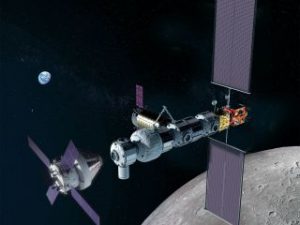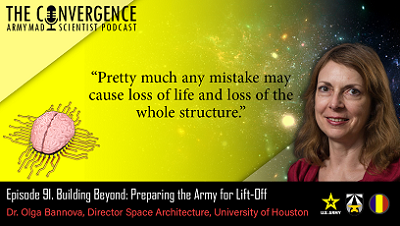“Pretty much any mistake may cause loss of life and loss of the whole structure.”
[Editor’s Note: As longtime readers of the Army’s Mad Scientist Laboratory know, our adversaries are deploying capabilities to fight the U.S. Joint Force through multiple layers of stand-off in all domains – space, cyber, air, sea, and land. Per the Defense Intelligence Agency‘s Challenges to Security in Space 2022: Space Reliance in an Era of Competition and Expansion:
 “Between 2019 and 2021 the combined operational space fleets of China and Russia have grown by approximately 70 percent. This recent and continuing expansion follows a period of growth (2015–2018) where China and Russia had increased their combined satellite fleets by more than 200 percent. The drive to modernize and increase capabilities for both countries is reflected in nearly all major space categories—satellite communications (SATCOM), remote sensing, navigation-related, and science and technology demonstration. Since early 2019, competitor space operations have also increased in pace and scope worldwide, China’s and Russia’s counterspace developments continue to mature, global space services proliferate, and orbital congestion has increased.”
“Between 2019 and 2021 the combined operational space fleets of China and Russia have grown by approximately 70 percent. This recent and continuing expansion follows a period of growth (2015–2018) where China and Russia had increased their combined satellite fleets by more than 200 percent. The drive to modernize and increase capabilities for both countries is reflected in nearly all major space categories—satellite communications (SATCOM), remote sensing, navigation-related, and science and technology demonstration. Since early 2019, competitor space operations have also increased in pace and scope worldwide, China’s and Russia’s counterspace developments continue to mature, global space services proliferate, and orbital congestion has increased.”
Preserving our advantage in the space domain is critical — a contemporary U.S. Army maneuver Brigade Combat Team (BCT) has over 2,500 pieces of equipment dependent on space-based assets for Positioning, Navigation, and Timing (PNT). This number of dependent systems will only increase as emerging technology on Earth demands increased bandwidth, new orbital infrastructure, niche satellite capabilities, and advanced robotics. Dominance in the space domain is vital to Joint Force and U.S. Army operations.
In our latest episode of The Convergence podcast, we sit down with Dr. Olga Bannova, Director of the Space Architecture Graduate Program, University of Houston, to discuss designing vehicles and habitats for space, how we can use austere environments here on Earth as proving grounds, and what these environments can teach the U.S. Army. — Enjoy!]
[If the podcast dashboard is not rendering correctly for you, please click here to listen to the podcast.]
 Dr. Olga Bannova, conducts research and design studies that address a variety of topics, including: planning analyses for a broad range of space vehicles, habitats, and systems; inflatable hydroponics laboratory and logistic modules; special design influences and requirements for different gravity conditions in space; and habitat concepts for extreme environments on Earth. She is a corresponding member of International Academy of Astronautics, IAC Space and Society Symposiums coordinator, senior member of the American Institute of Aeronautics and Astronautics, a Chair of the AIAA Space Architecture Technical Committee, and an elected member of the ASCE’s Executive Committee on Space Engineering and Construction. She recently received 2019 Outstanding Technical Contribution Award from the American Society of Civil Engineers (ASCE) Aerospace Division. Dr. Bannova earned her PhD from Chalmers University of Technology, Sweden, in 2016, and Master in Architecture and M.S. in Space Architecture from the University of Houston in 2001 and 2005. She authored Space Architecture Education for Engineers and Architects (Springer, 2016) and Space Architecture: Human Habitats Beyond Planet Earth (DOM Publishers, 2021). Prior to arrival to Houston, she worked as a professional architect in Moscow, Russia, on industrial, office, and healthcare projects. Several of her designs have been built in Moscow city, and in the Moscow and Leningrad Oblasts.
Dr. Olga Bannova, conducts research and design studies that address a variety of topics, including: planning analyses for a broad range of space vehicles, habitats, and systems; inflatable hydroponics laboratory and logistic modules; special design influences and requirements for different gravity conditions in space; and habitat concepts for extreme environments on Earth. She is a corresponding member of International Academy of Astronautics, IAC Space and Society Symposiums coordinator, senior member of the American Institute of Aeronautics and Astronautics, a Chair of the AIAA Space Architecture Technical Committee, and an elected member of the ASCE’s Executive Committee on Space Engineering and Construction. She recently received 2019 Outstanding Technical Contribution Award from the American Society of Civil Engineers (ASCE) Aerospace Division. Dr. Bannova earned her PhD from Chalmers University of Technology, Sweden, in 2016, and Master in Architecture and M.S. in Space Architecture from the University of Houston in 2001 and 2005. She authored Space Architecture Education for Engineers and Architects (Springer, 2016) and Space Architecture: Human Habitats Beyond Planet Earth (DOM Publishers, 2021). Prior to arrival to Houston, she worked as a professional architect in Moscow, Russia, on industrial, office, and healthcare projects. Several of her designs have been built in Moscow city, and in the Moscow and Leningrad Oblasts.
Army Mad Scientist sat down with Dr. Bannova to discuss designing vehicles and habitats for space, how we can use austere environments here on Earth as proving grounds, and what these environments can teach the U.S. Army. The following bullet points highlight key insights from our conversation:
-
-
-

Astronauts depart Gateway to return to Earth via the Orion spacecraft. / Source: NASA Space architecture entails designing and building habitable spaces for humans in outer space, ideally for extended periods of time. Mission planning is essential to the design process – understanding the details of the mission (purpose, location, duration) and the required engineering support.
-
-
-
-
- It is critical that systems designed for space integrate perfectly with the needs and ability of the crew, as well as the surrounding environment. Any design mistake can lead to loss of the structure, mission, and human life.
-
-
-
- Space architects attempt to replicate space characteristics for testing conducted on Earth. Air-tight facilities are used to test certain systems, such as life support systems, while operations and psychological effects can be tested in isolated or confined environments. Dr. Bannova’s lab recently constructed an extended reality facility combining low fidelity mockups with virtual habitat designs to test crew operations.
-
-
-
-

Images of a 3D rover model. / Source: UH’s Bannova Designing Moon Rovers, Habitats As the Army looks to operate in varying environments from dense urban to arctic conditions, systems must be designed through careful mission planning vice modifying or retrofitting current systems. Space conditions can be brutal to system integrity and employment, therefore space architecture concepts for robust structures, wheels, suspension, cargo and crew protection, and weight and payload restrictions can all be applied to Army system design for use in austere environments.
-
-

Stay tuned to the Mad Scientist Laboratory for our next episode of The Convergence podcast on 29 February 2024, in collaboration with the Breaking Doctrine podcast — featuring GEN Gary Brito, Commanding General, Training and Doctrine Command (TRADOC), Ian Sullivan, Deputy Chief of Staff for Intelligence, TRADOC G-2, and Richard Creed, Director, Combined Arms Doctrine Directorate — discussing the importance of threat doctrine, changes in the Operational Environment that drive new doctrine, and strengthening the Army profession by understanding the threat.
If you enjoyed this post, check out the following related Army Mad Scientist content:
LSCO, PNT, and the Space Domain, by CPT Matthew R. Bigelow
Space: Challenges and Opportunities
Star Wars 2050 and The Final Frontier: Directed Energy Applications in Outer Space, by proclaimed Mad Scientist Marie Murphy
Beyond Space and associated podcast, with proclaimed Mad Scientist Kara Cunzeman
Space 2035: A Surplus of Uncertainty and a Deficit of Trust, by Maj Rachel Reynolds
Table of Future Technologies: A 360 Degree View Based on Anticipated Availability, by Richard Buchter
… as well as the Dr. Moriba Jah on What Does the Future Hold for the US Military in Space? podcast hosted by our colleagues at Modern War Institute.
Disclaimer: The views expressed in this blog post and podcast do not necessarily reflect those of the U.S. Department of Defense, Department of the Army, Army Futures Command (AFC), or Training and Doctrine Command (TRADOC).



